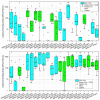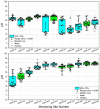A 22-Site Comparison of Land-Use Practices, E-coli and Enterococci Concentrations
- PMID: 36360790
- PMCID: PMC9658064
- DOI: 10.3390/ijerph192113907
A 22-Site Comparison of Land-Use Practices, E-coli and Enterococci Concentrations
Abstract
Land-use practices can greatly impact water quality. Escherichia (E.) coli and Enterococcus are accepted water quality indicators. However, surprisingly little research has been conducted comparing both organisms' population density relationships to land use practices and water quality. Stream water grab samples were collected monthly (n = 9 months) from 22 stream monitoring sites draining varying land use practice types in a representative mixed-land-use watershed of the northeastern United States. E. coli and enterococci colony forming units (CFU per 100 mL) were estimated (n = 396) and statistically analyzed relative to land use practices, hydroclimate, and pH, using a suite of methods, including correlation analysis, Principal Components Analysis (PCA), and Canonical Correspondence Analysis (CCA). Correlation analyses indicated significant (p < 0.05) relationships between fecal indicator bacteria concentrations, water quality metrics and land use practices but emphasized significant (p < 0.05) negative correlations between pH and instream enterococci concentrations. PCA and CCA results indicated consistent spatial differences between fecal indicator bacteria concentrations, pH, and land use/land cover characteristics. The study showed that pH could be considered an integrated proxy variable for past (legacy) and present land use practice influences. Results also bring to question the comparability of E-coli and enterococci relative to dominant land use practices and variations in pH and provide useful information that will help guide land use practice and water pollutant mitigation decision making.
Keywords: Escherichia coli; acid-mine drainage; enterococcus; fecal indicators; land use practices; water quality.
Conflict of interest statement
The authors declare no conflict of interest.
Figures








References
-
- Mukherjee A., Duttagupta S., Chattopadhyay S., Bhanja S.N., Bhattacharya A., Chakraborty S., Sarkar S., Ghosh T., Bhattacharya J., Sahu S. Impact of sanitation and socio-economy on groundwater fecal pollution and human health towards achieving sustainable development goals across India from ground-observations and satellite-derived nightlight. Sci. Rep. 2019;9:15193. doi: 10.1038/s41598-019-50875-w. - DOI - PMC - PubMed
-
- CDC . E. coli (Escherichia coli). Centers for Disease Control and Prevention, National Center for Emerging and Zoonotic Infectious Diseases (NCEZID), Division of Foodborne, Waterborne, and Environmental Diseases (DFWED) CDC; Atlanta, GA, USA: 2020.
Publication types
MeSH terms
LinkOut - more resources
Full Text Sources
Miscellaneous

